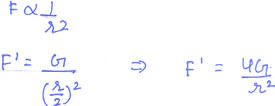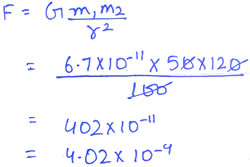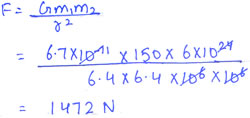Question: What happens to the gravitational force between two objects when the distance is:
Answer:
(1) Doubled
Force is made one fourth
(2) Halved
Question: Calculate the force of gravitation between two objests of masses 50 kg and 120 kg kept at a distance of 10 m. (6.67 × 10-11 Nm2 kg2)
Question: What is the force of gravity on a body of mass 150 kg lying on the surface of the earth? (Mass of the earth = 6 × 1024 kg2; Radius of earth 6.4 × 106 m; G = 6.7 × 10-11 Nm2 kg2)
Question: A piece of stone is thrown vertically upwards. It reaches the max hight in 3 sec. If the acceleration of the stone is 9.8 m/s2, calculate initial velocity.
Answer:
V = 0
t = 3 sec
a = 9.8 m/s2
Now, u = V-at
= 9.8 × 3
= 29.4 m/s
Question: A stone falls from a building and reaches the ground 2.5 seconds later. How high is the building? (g = 9.8 m/s2 )
Answer: We know,
S = ut + ½ at2 (u = 0), (t = 2.5), (a = 9.8)
S = ½ × 9.8 × 2.5 × 2.5
= 30.625 m
A stone is dropped from a height of 20m.
(1)how long will it take to reach the ground?
(2) What will be its speed when it hits the ground?
Answer:
(1) We know,
S = ut + ½ at2 (u = 0), (t = 2.5), (a = 9.8)
20 = o × t + ½ × 10 × t2
20 × 2/ 10 = t2
t2 = 2 sec
(2)
V = u + at
= 10 × 2
= 20 m/s
Question: Why is it difficult to hold a school bag having a strap made of a thin and strong string?
Answer: The force exerted by a thin and strong string is distributed to very less area and hence the force applied due to the bag is more, the pressure exerted on the body by thin straps will be more and hence will be more painful.
As pressure is inversely proportional to area, if the area is reduced pressure

Question: What do you mean by buoyancy?
Answer: The upward force exerted by any fluid (liquid, gas) on an object is known as upthrust or buoyancy.
Question: Why does an object float or sink when placed on the surface of water?
Answer: The density of the objects and water decides the floating or sinking of the object in water.
The density of water is 1 gm/cm3.
- If the density of an object is less than the density of water then the object will float.
- If the density of an object is more than the density of water then the object will sink.
Question: You find your mass to be 42 kg on a weighing machine. Is your mass more or less than 42 kg?
Answer: The weighing machine actually measures the weight of the body as the acceleration due to gravity ‘g’ is acting on the body. Hence the mass reading of 42 kg given by a weighing machine is same as the actual mass of the body. As mass is the quantity of inertia, it remains the same.
Question: You have a bag of cotton and an iron bar, each indicating a mass of 100 kg when measured on a weighing machine. In reality, one is heavier than other. Can you say which one is heavier and why?
Answer: The heaviness of the bag can be given by density
![]()
Mass of both cotton bag and iron bag is same. But the volume of cotton bag is more than the iron bag.
Hence density is inversely proportional to volume. The bag of iron will be heavier.
Question: In what direction does the buoyant force on an object immersed in a liquid act?
Answer: The buoyant force on an object immersed in a liquid acts upwards, i.e. opposite to the direction of the force exerted by the object.
Question: Why does sharp knife cut object s more effectively than a blunt knif?
Answer: A sharp knife has a very thin edge to its blade. A sharp knife cuts objects better because due to its very thin edge, the force of our hand falls over very small area of the object producing a large pressure. And this large pressure cuts the object easily. On the other hand, a blunt knife has a thicker edge. A blunt knife does not cut an object easily because due to its thicker edge, the force of our hand falls over a larger area of the object and produces lesser pressure. This lesser pressure cuts the object with difficulty.
Question: Why does a block of plastic released under water come up to the surface of water?
Answer: The floating or sinking of a body in the water is decided by the density of both the body and water’s buoyant force acting on the body by the liquid.
The density of plastic is less than the water and the buoyant force exerted by water on the plastic block is greater than the force exerted by plastic on the water.
Question: The volume of 50 g of a substance is 20 cm3. If the density of water is 1 gem 3, will the substance float or sink?
Answer:

As the density of a given substance is more than the density of water. The substance will sink in water.
 Class Notes NCERT Solutions for CBSE Students
Class Notes NCERT Solutions for CBSE Students









